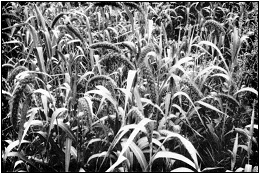 |
 |
To Print Use The pdf File
ILLINOIS URBAN MANUAL
PRACTICE STANDARD
TEMPORARY SEEDING
(acre or sq ft)
CODE 965
 (Source: VA Erosion and Sediment Control Handbook) |
DEFINITION
Planting rapid-growing annual grasses or small grains, to provide initial, temporary cover for erosion control on disturbed areas.
PURPOSE
The purpose of this practice is to temporarily stabilize denuded areas that will not be brought to final grade or on which construction will be stopped for a period of more than 14 working days.
Temporary seeding helps reduce runoff and erosion until permanent vegetation or other erosion control measures can be established. In addition, it provides residue for soil protection during seedbed preparation and reduces problems of mud and dust production from bare soil surfaces during construction.
CONDITIONS WHERE PRACTICE APPLIES
This practice applies to all cleared, un-vegetated, or sparsely vegetated soil surfaces where vegetative cover is needed for less than 1 year. Applications of this practice include diversions, dams, temporary sediment basins, temporary road banks, topsoil stockpiles and any other exposed areas of a construction site.
CRITERIA
Plant selection - Select plants appropriate to the season and site conditions from Table 1.
Site preparation - Prior to seeding, install necessary erosion control and sediment control practices if possible.
Remove large rocks or other debris that may interfere with seedbed preparation or seeding operations.
Seedbed preparation:
Seeding - Seed shall be evenly applied with a cyclone seeder, drill, culti-packer seeder or hydroseeder. Small grains shall be planted no more than one inch deep. Grasses shall be planted no more than one half inch deep.
Cover broadcast seedings by culti-packing, dragging a harrow, or raking.
Mulching - Seedings made during optimum spring and summer seeding dates, with favorable soil and site conditions, will not require mulch.
When temporary protection is needed see practice standard 875 MULCHING.
CONSIDERATIONS
Temporary seedings should be used to protect earthen structures such as dikes, diversions, dams and other structures used for sediment control during construction. Temporary seedings can also reduce the amount of maintenance these structures may need. For example, the frequency of sediment basin clean-outs will be reduced if watershed areas, outside the active construction zone, are stabilized.
Proper seedbed preparation, selection of appropriate species, and use of quality seed are as important in this practice as in practice standard PERMANENT VEGETATION 880. Failure to follow established guidelines and recommendations carefully might result in an inadequate or short-lived stand of vegetation that will not control erosion.
Temporary seeding provides protection for no more than 1 year, during which time permanent stabilization should be initiated.
PLANS AND SPECIFICATIONS
Plans and specifications for temporary seeding shall be in keeping with this standard and shall describe the requirements for applying the practice to achieve its intended purpose. At a minimum include the following items:
All plans shall include the installation, inspection, and maintenance schedules with the responsible party identified.
OPERATION AND MAINTENANCE
Reseed areas where seedling emergence is poor, or where erosion occurs, as soon as possible. Protect from vehicular and foot traffic. Control weeds by mowing.
NRCS IL December 1994
TEMPORARY SEEDING SPECIES, RATES AND DATES
|
Species |
Lbs./Acre |
Lbs./1000 ft.2 |
Seeding Dates |
|---|---|---|---|
|
Oats |
90 |
2 |
Early spring – July 1 |
|
Cereal Rye |
90 |
2 |
Early spring – Sept. 30 |
|
Wheat |
90 |
2 |
Early spring – Sept. 30 |
|
Perennial Ryegrass |
25 |
0.6 |
Early spring – Sept. 30 |